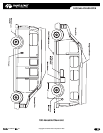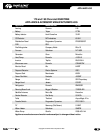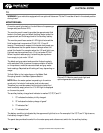
ELECTRICAL SYSTEM
DDoocc NNoo::
21906532-210C05
RReevv::
02
CCooppyyrriigghhtt ©© HHaannmmaarr MMoottoorr CCoorrppoorraattiioonn 22000055 EE--11
NOTE: INVERTER
Your Owner’s Manual for RV612ULHW contains most of the essential information you need to enjoy the electrical
conveniences of home while at RV parks or dry camping.However, we wish to highlight for you exactly how the
charging portion of the inverter/charger works, in order to help avoid possible confusion:
Supplying shore power or (optional) generator power enables RV612ULHW to charge the auxiliary battery (ies).
Operation of your vehicle engine and alternator will also charge the auxiliary battery (ies).When your motorhome
is not plugged-in to shore power or (optional) AC generator power, all electricity you use draws power from your
motorhome’s auxiliary battery bank, with the inverter allowing you to enjoy quiet DC-to-AC (12 volt to 120 volt)
power in the absence of shore or generator power.
10V inverter/charger shut down
As a safety feature,the inverter component of the RV612ULHW inverter/charger (which changes DC battery power
to AC electricity) will shut itself down when your auxiliary battery bank drops below 10 volts DC. This occurs in
order to avoid excessive discharging and potential damage to the battery (ies), as well as to preserve sufficient
battery voltage to maintain the functionality and readiness of the battery charger component of the RV612ULHW .
It is possible, however,for the battery (ies) to become discharged below 10 volts DC as a function of activity other
than using the inverter. For example, while dry camping,in the absence of shore or generator power, if a 12 volt
appliance such as the fridge, furnace or lights are left on for an extended period of time. In that event, the battery
charger component of the RV612ULHW will become inoperative.Therefore, after plugging into shore power or
supply of (optional) generator power, it is possible that the battery (ies) may not be recharging.The indicators of
this situation will be either completely dark LED lights on the monitor panel of the RV612ULHW inverter/charger,
and a continuously blinking red LED light on the battery voltage readout,or all three LED lights continuously
blinking on the battery voltage readout on the RV612ULHW.
Inverter/charger start up after automatic safety shut down
To remedy this situation, start the automotive engine,to allow the charger to sense a voltage of higher than 10
volts. The indicator of success will be a transition on the monitor panel from yellow inverted power LED light to the
green line power illuminated LED light.This may take up to 60 seconds. At this point the engine can be turned off,
because the charger has been activated and “takes over”the function of charging the battery (ies). Once battery
voltage has risen sufficiently for your purposes (e.g., to the yellow, yellow-green, or green “full charge”level), shore
power or (optional) generator power can be disconnected, although disconnection is not required; the charger will
automatically reduce the rate of charge to prevent the battery (ies) from becoming overcharged.
Dry camping battery conservation
While dry camping, (no 110 VAC power available) to conserve battery power, it is recommended to switch the
inverter to the off or charge position,if the inverter is left in the ON position, it will continue to draw 1.25 amps.To
ease in switching of the inverter,we recommend installation of the optional remote switch and harness, (Part #
APSRM4).
Receptacle functionality
When using your motorhome and connected to shore power or optional generator, the receptacles in the
audio/video cabinet and in the galley will function to the 15 amp capacity supplied from the distribution panel.
However when no shore power or option generator power is available,these receptacles are limited to the 600
watts,(6 amps) output from the inverter.
If an overload occurs, the inverter will shut down, and will need to be reset manually,by turning of the inverter off
for 1 minute, removing the load, and then turn the inverter back on.


















